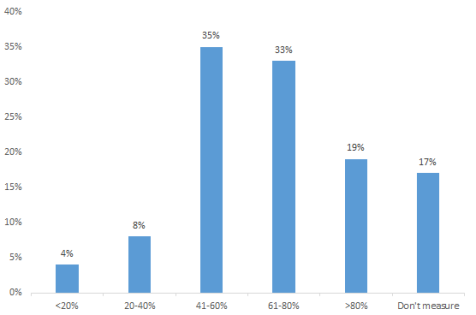For many service desks, First Call Resolution (FCR) is the “holy grail” of metrics, but should it be?
Like any metric, First Call Resolution is just a number. It will tell you something—but not everything—about your service desk performance. You need to consider FCR as part of a balanced set of metrics and strive to understand why your FCR number is what it is.
What’s Your First Call Resolution Rate?
According to the Service Desk Institute, 83% of organizations measure First Call Resolution rates, with the majority of organizations (68%) recording FCR rates in the 41-80% range.

Source: Service Desk Institute, 2019
What can this tell us? It tells us that in most organizations, service desk agents are armed with at least some of the knowledge and empowering actions they need to solve issues without escalation. Beyond that, we can’t really tell much because every organization is different and faces a different volume and mix of incident types.
What’s more important is understanding what your FCR rate can tell you about the health of your service desk. For such a seemingly simple number the answer is not as simple as you might think. There are multiple factors which affect FCR rates—and all of these should be understood before you can get the most out of the First Call Resolution metric.

Understanding Your FCR Number
A high FCR rate isn’t necessarily good, nor is a low number bad. There are many factors which can influence your FCR rate and each one should be examined—not just because they impact service desk metrics but because they impact operational costs, IT customer satisfaction, and business productivity:
- People & Empowerment: When service desk agents are highly trained, and empowered with the tools they need to resolve issues without escalation, this drives the FCR rate up. This is a good thing. Conversely, when analysts are not properly trained or empowered, expect a low FCR rate.
- Infrastructure Quality: If you have a very robust and resilient infrastructure, there will be fewer new issues (novel issues which often cannot be resolved in the first instance). Old and unreliable infrastructure will present a steady stream of complex issues which may need to be escalated to your network, server, database, or application teams—or out to third party suppliers.
- No Innovation: Similarly, if your IT ecosystem is stagnant and isn’t growing and adapting to meet new business demands there will be fewer novel types of incident and a higher FCR rate. The new systems, apps, services that the business needs to improve performance may create demands on the service desk, but change and risk are both necessary parts of business life.
- Robust IT processes: If you have extremely mature and robust service design and change control processes in place, and you are delivering new innovations quickly and safely with little ‘fall-out’, you will have a lower novel incident count and a higher FCR rate. Most organizations find that they have a high FCR rate because they are good at handling the same repeat issues over and over again, not because they have extremely resilient and mature infrastructure and operations processes.
- Suppliers: When you have consistent and reliable suppliers, this reduces the number of calls which must be escalated beyond the service desk to the supplier. By default, supplier escalations are not resolvable by the service desk, so they lower the FCR rate. Better suppliers means fewer escalations and an opportunity for a higher FCR rate.
- Gaming the System: If your service desk agents are closing incident tickets on the first call when the issue isn’t really fixed for the IT customer, this will falsely increase your FCR rate. This must be stopped as it skews your FCR number and hides the truth.
- Unnecessary Workload: Often, a service desk gets really great at fixing repeat issues out of necessity. In the absence of an efficient Problem Management function, the same incidents continue to flow into the service desk, consuming time, effort, and budget when these issues should not exist.
What Can I do to Improve FCR?
The only way to find out what your FCR number really means to your organization (and what you should do about it) is to pull information on the types and frequencies of incidents, analyse the data, and have candid conversations with service desk agents about the work they do and how they do it. Study the system to understand its influences and nuances. Find out why your First Call Resolution is too high, or too low. Typical actions coming from data analysis usually include:
- If you have a very low FCR, ask your analysts about what training and tools they need to be more effective at solving IT customer issues without escalation to more expensive 2nd and 3rd line support tiers.
- When infrastructure issues are a big problem, dive into which Configuration Item (CI) types are creating the biggest problems and think about upgrade or replacement. Establish a pro-active Problem Management function to analyse infrastructure data, identify weaknesses, and plan actions to eliminate infrastructure errors that manifest as novel incidents. This will decrease FCR but also reduce costs and improve business productivity.
- If you are suffering from a large number of novel incident types, this may be the fall-out from a weak change control process. Track incidents back to changes, analyse their causes, and change the way work happens to ensure new innovations are transitioned more smoothly into production (e.g. DevOps), reducing the number of novel incident types. Fewer novel incidents translates into higher FCR rate.
- Ask your service desk agents which high-volume repeat incidents could easily be eliminated through simple changes. They will be acutely aware of these as they see them on a daily basis. Working with Problem and Change Management can quickly resolve these once and for all. This reduces the FCR rate but allows service desk agents to spend more time solving and documenting novel incident types (which grows the organizational pool of knowledge and capabilities).
- Apply detect-and-correct automation to automatically sense and resolve error conditions before they impact end users and manifest as calls to the service desk. Automation can prevent a large volume of first-call-resolvable incidents from hitting your service desk, causing a drop in your FCR rate but for a very healthy reason.
FIND OUT MORE:

